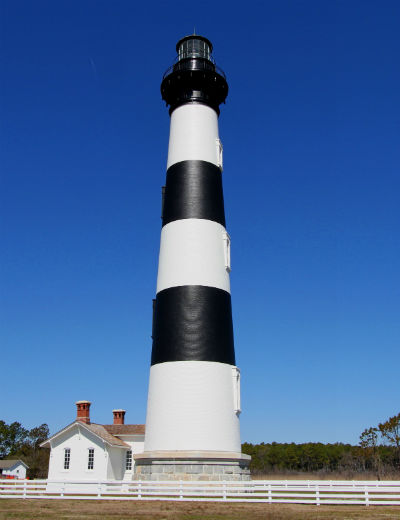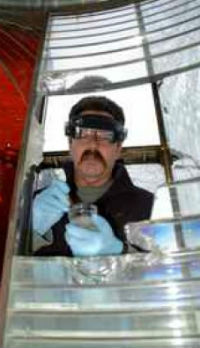Reprinted from the Island Free Press
 Visitors for the first time will be about to climb the restored Bodie Island Lighthouse, starting Thursday. Photo: Sam Bland |
NAGS HEAD — Even as birds nested where metalwork had rusted away and rain spit through broken glass and rotted window frames, the historic Bodie Island Lighthouse always had the fortune of a picturesque setting and appealing architecture.
But the 1872 brick beacon, which the Lighthouse Digest added to its Doomsday List just 13 years ago, has its own tale of survival, rescued from decades of budgetary starvation, careless neglect and preservation perils.
Supporter Spotlight
On Thursday, the black-and-white banded tower, now completely restored, will be opened for climbing for the first time and its rare first order Fresnel lens will be reactivated.
The 156-foot lighthouse is on the National Register of Historic Places. Its preservation is more significant because the lens, a majestic 10-foot high beehive of 344 clear green prisms angled precisely within metal panels, is the same one that was installed originally – a boast few other lighthouses can make.
For Cheryl Roberts, the relighting ceremony is more like an apogee of a nearly 20-year labor of love.
“It’s almost like after raising a child, and seeing that child graduate,” said Roberts, who with her husband, Bruce Roberts, founded the Outer Banks Lighthouse Society in 1994 to help save the Bodie Island Lighthouse.
“To see that door open and see those people going up those steps –I can’t wait!”
Supporter Spotlight
It was just a few weeks ago that the 1,850-pound lens that Joe Cockin, a lens restoration expert, took the lens from storage and hoisted it the tower .
Cocking, a Coast Guard veteran and Fresnel lens specialist, said that the most challenging part of the $100,000 conservation was physical. The Bodie lens was in fair condition, he said, requiring mostly new putty and stabilization. To maintain its historic integrity, the two missing prisms were not replaced.
“It’s very unique,” he said about the original first order lens. “They’re becoming fewer and fewer.”
Before work began on the lighthouse restoration, the lens had to be disassembled and put in storage. Volunteers with the Lighthouse Society, which today has about 500 members, gently cleaned each of the prisms with a special powder and chamois cloth and packed them away, Roberts said.
“That lens was so dirty,” she said “It was just a shame.”
Fingerprints were visible on some of the elements. There were chips in the prisms where ladders had leaned against them. One prism even had someone’s initials carved into it.
When the lens was put back together, each prism had to be adjusted perfectly while the putty was soft.
 The lighthouse has been encased in scaffolding since 2008 when the restoration began. Photo: NPS |
No doubt the Roberts’ persistence and dedication had spurred the U.S. Coast Guard and the National Park Service to work toward preserving the tower for future generations.
Roberts said that her husband, a renowned photographer, had already published books on lighthouses and the couple shared an interest in lighthouse preservation.
When they first got involved at Bodie Island, the stairs were behind a chain link fence and the public was not allowed into the oil house to see the spiral staircase. With the door constantly closed, the contained moisture made it literally rain inside.
 Cheryl Roberts |
The Roberts persuaded the Park Service and the Coast Guard to allow them to clean up the area, open the doors, and let people in for a few hours a day to learn about the lighthouse history.
“Our goal was to stir interest,” she said.
It was obvious to them that the constant moisture – a result of the tower being unmanned since 1940– had caused alarming deterioration. At the society’s behest, Cullen Chambers, a well-known lighthouse restoration expert ,inspected the tower in 1996 and again in 1998 and found serious deterioration and water damage, including weakened iron support brackets.
“It was in terrible shape,” Roberts recalled about Chambers’ assessment. “He was very disturbed.”
Previous government inspections, starting in 1989, also found increasing concern about corroded ironwork, peeling plaster, chipped layers of lead paint, cracked masonry, electrical problems and overall structural integrity.
In a prescient warning, Chambers suggested that the Park Service fence the base of the lighthouse to protect the public from falling chunks of iron. But the fence was not built until 2004, when two large chunks of iron fell harmlessly from the gallery.
According to the Park Service’s 2004 Historic Structural Report, there was apparent confusion between the Park Service and the Coast Guard, which had a partnership, about which agency was responsible for maintenance of the tower.
“Work is not done until a major complication arises,” the report said.
There was also a difference in priorities: The Coast Guard, which owned the tower and the lens, regarded the lighthouse as an aid to navigation for mariners, a role the lighthouse still served. The Park Service, on the other hand, looked at the tower as a historic structure to preserve. But as the report indicated, the intersection of missions did not seem to serve the lighthouse’s long-term prospects.
In July 2000, the long-sought transfer of the lighthouse was made by the Coast Guard to the Park Service, with the Coast Guard continuing to own the Fresnel lens.
By then, the structure the Park Service had wanted for so long was in a sorry state.
Probably coincidentally, two months after the transfer, it was added to the Doomsday List.
To the consternation of lighthouse lovers, in March 2003 the Coast Guard announced that it intended to replace the first order Fresnel lens with a plastic light in order to save money.
A furious public reaction persuaded the Coast Guard to back off. After the Park Service agreed to take the navigational aid responsibility in 2005, the Coast Guard transferred the lens.
Funding came in little spurts initially, allowing several emergency repairs in the early 2000s. A budget request was later approved, and the Park Service planned to start restoration in 2008. But Congress pulled the funding from the budget in late 2007. In March 2009, $3 million was appropriated, and the restoration finally began in September.
 Joe Cockin restored the lighthouse’s Fresnel lens. Photo: Lighthouse Lamp Shop |
But the surprises weren’t over. With the lighthouse nearly completely restored, the lens safely in storage, the Park Service announced in January 2011 that additional work was required to fix the gallery –and another $1.6 million was needed. The elaborate scaffolding surrounding the tower was all removed while the agency sought more money.
Finally, with funds secured, the scaffolding was put back and repair work resumed in March 2012.
Doug Stover, historian for Cape Hatteras National Seashore, said that the project included replacement of 32 stair treads and support beams under the lens. During the restoration, it was discovered that the light had been off-center for years because one side had been drooping.
“So now that light will shine a level 19 nautical miles,” he said.
Climbing will be more restricted than at the Cape Hatteras Lighthouse, he said, because the staircase, with 205 steps, is not capable of bearing as much weight. No more than 20 people at a time will be allowed to climb, a maximum of 370 a day.
Those who climb to the balcony will be greeted with a panoramic view of vast marshlands, the Pamlico Sound, the Atlantic Ocean, Oregon Inlet and the Bonner Bridge.
Stover, who has been with the seashore since 2000, said that the lighthouse will be closely monitored –and regularly maintained — from now on.
“It’s amazing,” he said about the restoration, which totaled about $5 million. “I’ve been working on this project since I’ve been here.”
Stover said he remembers the tower’s condition 13 years ago, when there were so many layers of paint “that’s practically what was keeping it together,” and the years of disappointment and discouragement in the effort to get it restored.
Much of the credit, he said, goes to the Outer Banks Lighthouse Society for keeping the public’s attention and pressure on the need for the restoration of a national treasure.
Bett Padgett, the group’s president, said she is eagerly anticipating seeing the completed tower at the relighting celebration.
“Pinch me,” she said. “We are ecstatic.”








